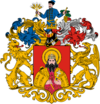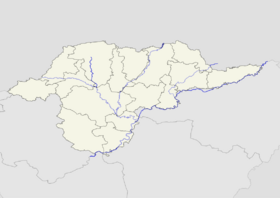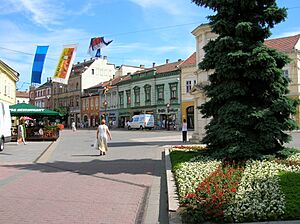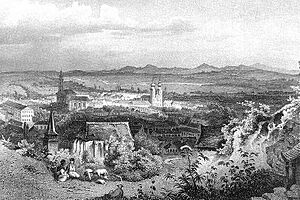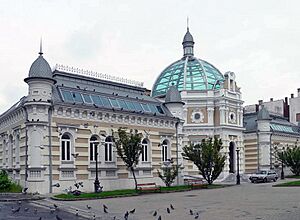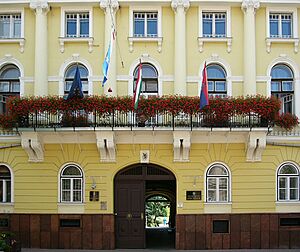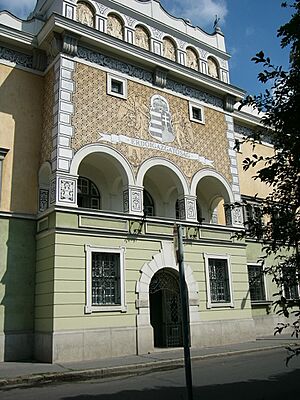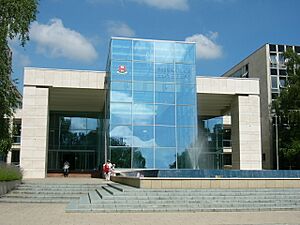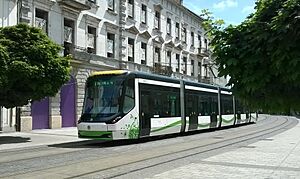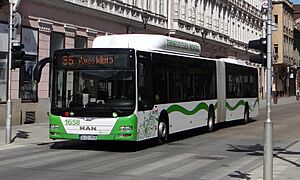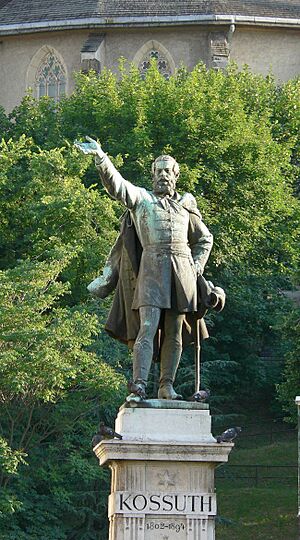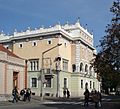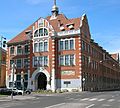Miskolc facts for kids
Quick facts for kids
Miskolc
|
|||||
|---|---|---|---|---|---|
|
City with county rights
|
|||||
| Miskolc Megyei Jogú Város | |||||

Clockwise from the top left corner:
Avas TV Tower, Castle of Diósgyőr, Széchenyi Street, National Theatre of Miskolc, Cave Bath, Ottó Herman Museum, University of Miskolc, Palace Hotel of Lillafüred |
|||||
|
|||||
| Nickname(s):
Steel City
City of the Open Gates |
|||||
| Country | |||||
| Region | Northern Hungary | ||||
| County | Borsod-Abaúj-Zemplén | ||||
| District | Miskolc | ||||
| Established | 9th century AD | ||||
| Market town | 1365 | ||||
| Area | |||||
| • City with county rights | 236.68 km2 (91.38 sq mi) | ||||
| Elevation | 131 m (430 ft) | ||||
| Highest elevation | 945 m (3,100 ft) | ||||
| Lowest elevation | 110 m (360 ft) | ||||
| Population
(1 January 2019)
|
|||||
| • City with county rights | 154 521 |
||||
| • Rank | 4th in Hungary | ||||
| • Density | 664.09/km2 (1,720.0/sq mi) | ||||
| • Urban | 294,144 (3rd) | ||||
| Demonym(s) | miskolci | ||||
| Time zone | UTC+1 (CET) | ||||
| • Summer (DST) | UTC+2 (CEST) | ||||
| Postal code |
3500 to 3549
|
||||
| Area code | (+36) 46 | ||||
| Motorways | M30 Motorway | ||||
| NUTS 3 code | HU311 | ||||
| Distance from Budapest | 182 km (113 mi) East | ||||
| MP | Katalin Csöbör (Fidesz) György Hubay (Fidesz) |
||||
Miskolc is a big city in northeastern Hungary. It's known for its factories and industries. With over 150,000 people, Miskolc is the fourth largest city in Hungary. It's also the main city of the Borsod-Abaúj-Zemplén county and a key center for Northern Hungary.
Contents
What's in a Name?
The name Miskolc comes from the Slavic name Miško, which is a short form of Michael. The name might be linked to an old family or clan called Miskóc. This family was mentioned in old writings around the year 1200.
Exploring Miskolc's Geography
Miskolc is located where different types of land meet. It's east of the Bükk mountains, in the valley of the Sajó river and the Hejő and Szinva streams. The city covers about 236 square kilometers. The land gently slopes, with a big difference of about 800 meters between the highest and lowest points.
The lowest areas are near the Sajó river, about 110-120 meters above sea level. This part is flat and made of soft rocks. Between the Avas hill and Diósgyőr, there are rolling hills. These hills are made of sandstone, clay, and volcanic rocks.
Higher up, between Diósgyőr and Lillafüred, the mountains are between 400 and 600 meters high. This area has limestone and dolomite rocks. The highest parts, called the Higher Bükk, are 600-900 meters high. Here, you can find many caves. Miskolc is also famous for having the coldest temperature ever recorded in Hungary, which was -35°C!
Miskolc's Climate
Summers in Miskolc are often fresh, but can sometimes be warm and humid. Daytime temperatures often reach 20-30°C or even higher. Winters bring snow and ice. Miskolc gets about 120 centimeters of snow each year. Days below freezing and nights below -20°C are common in winter.
| Climate data for Miskolc, 1991−2020 normals, extremes 1961-2020 | |||||||||||||
|---|---|---|---|---|---|---|---|---|---|---|---|---|---|
| Month | Jan | Feb | Mar | Apr | May | Jun | Jul | Aug | Sep | Oct | Nov | Dec | Year |
| Record high °C (°F) | 16.1 (61.0) |
18.9 (66.0) |
25.8 (78.4) |
29.9 (85.8) |
33.3 (91.9) |
36.4 (97.5) |
39.3 (102.7) |
38.1 (100.6) |
34.8 (94.6) |
28.1 (82.6) |
22.2 (72.0) |
16.6 (61.9) |
39.3 (102.7) |
| Mean daily maximum °C (°F) | 2.0 (35.6) |
4.8 (40.6) |
11.0 (51.8) |
17.7 (63.9) |
22.5 (72.5) |
26.1 (79.0) |
28.1 (82.6) |
28.0 (82.4) |
22.3 (72.1) |
15.7 (60.3) |
8.7 (47.7) |
2.6 (36.7) |
15.8 (60.4) |
| Daily mean °C (°F) | −1.3 (29.7) |
0.6 (33.1) |
5.7 (42.3) |
11.5 (52.7) |
16.2 (61.2) |
19.9 (67.8) |
21.5 (70.7) |
21.2 (70.2) |
16.1 (61.0) |
10.4 (50.7) |
5.0 (41.0) |
−0.1 (31.8) |
10.6 (51.1) |
| Mean daily minimum °C (°F) | −3.9 (25.0) |
−2.6 (27.3) |
1.1 (34.0) |
6.0 (42.8) |
10.6 (51.1) |
14.4 (57.9) |
16.0 (60.8) |
15.6 (60.1) |
11.2 (52.2) |
6.2 (43.2) |
2.1 (35.8) |
−2.6 (27.3) |
6.2 (43.2) |
| Record low °C (°F) | −32.6 (−26.7) |
−35.0 (−31.0) |
−22.0 (−7.6) |
−9.7 (14.5) |
−2.8 (27.0) |
−0.9 (30.4) |
3.9 (39.0) |
3.1 (37.6) |
−3.9 (25.0) |
−12.8 (9.0) |
−22.4 (−8.3) |
−27.0 (−16.6) |
−35.0 (−31.0) |
| Average precipitation mm (inches) | 28.0 (1.10) |
35.3 (1.39) |
31.3 (1.23) |
47.4 (1.87) |
67.0 (2.64) |
85.0 (3.35) |
91.1 (3.59) |
64.6 (2.54) |
53.8 (2.12) |
56.8 (2.24) |
44.6 (1.76) |
39.0 (1.54) |
643.9 (25.35) |
| Average precipitation days (≥ 1.0 mm) | 5.6 | 5.7 | 5.1 | 6.9 | 9.4 | 9.0 | 9.3 | 6.7 | 6.3 | 6.6 | 6.7 | 6.8 | 84.1 |
| Average relative humidity (%) | 81.3 | 75.1 | 63.4 | 59.8 | 63.5 | 65.2 | 64.6 | 64.5 | 70.5 | 77.3 | 83.2 | 84.5 | 71.1 |
| Average dew point °C (°F) | −5.3 (22.5) |
−3.1 (26.4) |
−0.1 (31.8) |
4.1 (39.4) |
9.4 (48.9) |
12.5 (54.5) |
13.7 (56.7) |
13.5 (56.3) |
10.5 (50.9) |
5.8 (42.4) |
1.4 (34.5) |
−2.9 (26.8) |
5.0 (40.9) |
| Mean monthly sunshine hours | 40.8 | 69.5 | 128.4 | 177.2 | 224.0 | 224.2 | 254.5 | 236.4 | 180.8 | 141.6 | 53.2 | 36.0 | 1,766.6 |
| Source: NOAA (sun and dew point for 1961-1990) | |||||||||||||
Miskolc Through Time
People have lived in the Miskolc area for a very long time, over 70,000 years! The first known people here were the Cotini, a Celt tribe. Hungarians settled here in the late 800s. The city was first mentioned by name around 1210 AD.
In 1365, King Louis I made Miskolc a market town. He also turned the castle in nearby Diósgyőr into a beautiful Gothic fortress. The city grew, but its development slowed down during the Ottoman rule of Hungary. The Ottomans took Miskolc in 1544. During this time, Miskolc became an important center for growing grapes and making wine. By the late 1600s, Miskolc was as big as Košice.
In the early 1700s, there was a war for independence against the Habsburg rulers. Prince Francis II Rákóczi, the Hungarian leader, set up his headquarters in Miskolc. The city was attacked and burned in 1707. A few years later, a cholera sickness affected many people. But Miskolc recovered quickly!
A new time of growth began. In 1724, Miskolc was chosen as the place for the county hall of Borsod county. Many important buildings were built in the 1700s and 1800s. These included the city hall, schools, churches, a synagogue, and the theater. The theater is often called Hungary's first stone-built theater. By 1786, Miskolc had almost 15,000 people and over 2,400 houses.
Despite the growth, Miskolc faced challenges. A cholera outbreak in 1873 and a big flood in 1878 caused a lot of damage. Many buildings were destroyed, but even bigger and better ones were built in their place. World War I didn't directly hit the city, but many people were affected. After the war, between 1918 and 1919, troops from Czechoslovakia occupied the city.
After the Treaty of Trianon, Hungary lost some of its land, including the city of Kassa (now Košice, Slovakia). This made Miskolc the main regional center for northern Hungary. This helped the city grow a lot in the 1930s and 1940s.
During World War II, Miskolc became a major center for heavy industry. In 1944, many Jewish people from Miskolc were forced to leave their homes and were sent to concentration camps. After the war, some survivors returned. The Jewish cemetery in Miskolc has a memorial to remember those who suffered. After the war, there were some difficult times and conflicts in the city.
Miskolc recovered quickly after the war. It grew by joining with nearby villages, becoming the second-largest city in Hungary with over 200,000 people. In 1949, the University of Miskolc was founded.
Through its long history, Miskolc has survived fires, floods, diseases, and invasions. It has always remained an important city in northeastern Hungary. In the 1990s, the iron industry faced problems, and the city's population decreased.
Today, Miskolc is working to become known as a cultural city, not just an industrial one. One important event is the International Opera Festival held every summer.
Popular places to visit in Miskolc include Tapolca, Lillafüred, and Felsőhámor. Tapolca has a park with a boating pond and the special Cave Bath. Lillafüred and Felsőhámor are beautiful villages in a valley surrounded by mountains. You can see the Hotel Palace by Lake Hámori, the Szinva waterfall, and the Anna and István Caves.
Miskolc's Population
| Historical population | ||
|---|---|---|
| Year | Pop. | ±% |
| 1870 | 21,199 | — |
| 1890 | 30,408 | +43.4% |
| 1900 | 61,160 | +101.1% |
| 1910 | 76,207 | +24.6% |
| 1920 | 85,151 | +11.7% |
| 1930 | 93,877 | +10.2% |
| 1941 | 114,674 | +22.2% |
| 1949 | 109,124 | −4.8% |
| 1960 | 143,903 | +31.9% |
| 1970 | 180,581 | +25.5% |
| 1980 | 207,303 | +14.8% |
| 1990 | 196,442 | −5.2% |
| 2001 | 185,567 | −5.5% |
| 2011 | 167,754 | −9.6% |
| 2022 | 145,735 | −13.1% |
Religion in Miskolc
Religion in Miskolc (2022) Roman Catholicism (23.4%) Calvinism (14.3%) Greek Catholicism (4%) Evangelical Christianity (0.8%) Other (1.7%) Undeclared (43.6%) Irreligion (12.2%)
The main religions in Miskolc are Roman Catholicism, Calvinism, and Greek Catholicism.
Miskolc's Economy
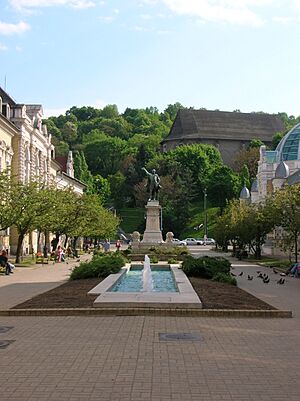
Miskolc is often seen as an industrial city. Its economy grew a lot during the Socialist era because of industrialization. However, industry has a long history here.
Miskolc was an important market town in the Middle Ages because it was near major trade routes. After the Ottoman rule, its economy really started to grow. In the 1700s, the town had a lumber mill, a paper factory, a brewery, and many other workshops. Glass factories and iron furnaces appeared in the late 1700s and early 1800s. The second iron furnace, built in 1813, can still be visited today. Many new villages were built in the Bükk mountains for workers. Some of these, like Alsóhámor and Ómassa, are now part of Miskolc.
Development sped up in the late 1800s, partly because of new railway lines. A large furnace, the second biggest in Hungary, was built in Diósgyőr. Other factories were also built, and mining became very important. The city's population doubled in forty years. Miskolc grew into "Greater Miskolc" by joining with Diósgyőr and other nearby towns. This helped Miskolc become a major industrial center. Its growth peaked in the 1980s, when the metal factory had over 18,000 workers.
After the Socialist era ended, industrial cities like Miskolc faced economic challenges. Many people lost their jobs, and the population decreased. However, the city successfully recovered. International companies and supermarkets opened. The local government is now working to make Miskolc a strong cultural and tourist city. By 2004, the M3 highway reached the city, making travel easier.
Sports in Miskolc
The most popular sport in Miskolc is football. The city's main club is Diósgyőri VTK (DVTK). They have won the Hungarian Cup many times and played in European competitions. Their stadium, DVTK Stadion, can hold over 14,000 fans.
Another football team is Miskolci VSC. Miskolc also has other former top-division teams like Miskolci AK and Perecesi TK.
Miskolc's successful women's basketball team, DKSK Miskolc MISI, has won the National Cup twice. The DVTK Jegesmedvék ice hockey team plays in the Slovak-based Tipsport Liga. Their home is the Miskolc Ice Hall, which opened in 2006. The women's volleyball team of MVSC also plays at the highest Hungarian level.
Parts of Miskolc
Avas
The Avas is a hill (234 meters high) in the middle of Miskolc. On top of the hill is the Avas lookout tower, a symbol of the city. On the northern side, near downtown, is the Gothic Protestant Church of Avas. This is one of Miskolc's oldest buildings. The limestone caves on Avas are used as wine cellars. The narrow, winding streets here give the area a special feel. The southern part of Avas has the city's largest housing estate, with tall concrete buildings where about one-third of the city's people live.
City Centre (Belváros)
Miskolc's city center has a charming 19th-century style, especially on Main Street (Széchenyi St.), City Hall Square, and Elizabeth Square. You'll find both historic buildings and modern shopping malls and offices here.
Diósgyőr
Diósgyőr is famous for its medieval castle. Miskolc's football team is named after Diósgyőr because their stadium is there. The steel factory that made Miskolc a major industrial city is also in this area.
University Town (Egyetemváros)
The University of Miskolc was built in the 1950s, so its buildings are quite modern. University Town is a newer part of the city, located between Miskolc and the holiday resort Miskolctapolca. The university, its campus, and sports facilities are surrounded by a large park.
Hejőcsaba and Görömböly
These were two separate villages that became part of the city in 1945 and 1950. Görömböly still feels like a small town on its own.
Lillafüred
Miskolc-Lillafüred is a beautiful holiday resort village surrounded by the Bükk mountains. Its most famous building is the Palace Hotel.
Martin-Kertváros
Martin-Kertváros is a suburban area of Miskolc.
Miskolctapolca
Miskolctapolca is one of Hungary's most famous holiday resorts. It's home to the unique Cave Bath, which is a natural cave with warm thermal water. Tapolca is a bit far from the city center and is a popular place for tourists.
Alsóhámor, Bükkszentlászló, Felsőhámor, Ómassa, Szirma
These villages were added to the city between 1950 and 1981. They still feel like separate villages, connected to Miskolc by its public transport system.
Main Sights to See
Downtown
- Main street and City Hall Square: Experience the charm of 19th-century Hungarian towns.
- Gothic Protestant Church of the Avas Hill: One of Miskolc's oldest churches.
- Greek Orthodox Church: See the largest iconostasis (a wall of icons) in Central Europe.
- House of Arts: Home to art cinemas.
- Kós House: A unique building designed in Art Nouveau and folk style.
- Mindszent Church
- Minorite Church and Heroes' Square
- Miskolc-Avas TV Tower: A symbol of the city.
- National Theatre of Miskolc
- Csodamalom Puppet Theatre
- Ottó Herman Museum
- Palace of Music
- Wooden Church
Diósgyőr
- Castle of Diósgyőr: A medieval castle where medieval plays are held every August.
- Lutheran church of Diósgyőr
- Protestant church of Diósgyőr: A Baroque church built on old monastery ruins.
Lillafüred
- Anna Cave, István Cave, Szeleta Cave: Explore these natural caves.
- Hotel Palace: A grand hotel by the lake.
- Lake Hámori: A beautiful lake.
- Trout Farm: See how trout are raised.
- Waterfalls: The highest waterfall in Hungary.
There's a fun narrow-gauge railway called the Lillafüred Forest State Railway that connects Lillafüred to Miskolc. It goes through lovely forests and is great for tourists.
Miskolctapolca
- Cave Bath of Miskolctapolca: A unique natural cave with thermal water.
Near the City
- Bánkút ski resort: For winter sports fun.
- Bükk Mountains: Great for hiking and exploring nature.
- Miskolc Zoo
- Ruins of the monastery at Szentlélek
- Castell Earl Andrassy Tiszadob
Festivals in Miskolc
- Diósgyőr Castle Plays: Held every May and August.
- International Soldiers and Military Bands Festival: Happens every two years in August.
- Jelly festival: A unique food festival in February.
- Miskolc Opera Festival: Held every summer.
- Miskolc International Film Festival: Takes place every September.
Schools in Miskolc
- Avasi Grammar School
- Ferenc Földes Secondary School
- Kossuth Lajos Lutheran Grammar School and Pedagogical Secondary School
- Lévay József Református Gimnázium és Diákotthon
- Béla Bartók Music High School
- Zrínyi Ilona Grammar School
- Fáy András Economic High School
- Berzeviczy Gergely School of Trade and Catering
Getting Around Miskolc
Public transport in Miskolc is run by the company MVK Zrt.. They have 36 bus lines and 2 tram lines. Miskolc was one of the first cities in Hungary to have trams (since 1897) and scheduled bus lines (since 1903). Today, Miskolc's public transport is considered one of the best in Hungary. There are also several taxi companies.
The Lillafüred Forest Train connects Diósgyőr to Lillafüred and is a popular tourist attraction.
The city has two railway stations (Tiszai and Gömöri). There's also a small airport, but it's mainly used for sports and not for public travel since 1963.
Famous People from Miskolc
This list includes people born in Miskolc, Diósgyőr, and other areas that are now part of Miskolc.
- Bela Borsody Bevilaqua (1885–1962) – A historian of culture.
- Péter Biros (born 1976) – A water polo player.
- Gizella Bodnár, "Airplane Gizi" (1926-2019) – A famous thief.
- Alan A. Brown (1928–2010) – An economist.
- Gábor Dayka (1769–1796) – A poet.
- Ferenc Demjén (born 1941) – A singer.
- Sándor Ferenczi (1873–1933) – A psychoanalyst.
- Dezső Földes (1880–1950) – An Olympic champion saber fencer.
- Endre Granat (born 1937) – A violinist.
- Alexander Grossmann (1909–2003) – A Swiss writer and journalist.
- Károly Grósz (1930–1996) – A politician and president.
- Dezső Gyarmati (1927–2013) – A water polo player.
- Szabolcs Huszti (born 1983) – A football player.
- Márk Jedlóczky (born 1999) – A racing driver.
- István Jónyer (born 1950) – A table tennis player.
- Máté Kamarás (born 1976) – A singer and actor.
- Tamás Pál Kiss (born 1991) – A racing driver.
- Julius Leopold Klein (1810–1876) – A German writer.
- Róza Laborfalvi (1817–1886) – An actress.
- Regina Margareten (1863–1959) – A businesswoman.
- Dénes Pál (born 1991) – A singer.
- László Palóczy (1783–1861) – A politician.
- Emeric Pressburger (1902–1988) – An Academy Award–winning movie director, writer, and producer.
- Sándor Puhl (1955–2021) – A football referee.
- Ladislau Raffinsky (1905–1981) – A Romanian football player.
- Ede Reményi (1828–1898) – A violinist.
- Attila Repka (born 1968) – A wrestler and Olympic champion.
- Sándor Rónai (1892–1965) – A politician and president.
- Anna Rudolf (born 1987) – A chess player and reporter.
- Andrei Șaguna (1809–1873) – A Romanian political leader and bishop.
- Vera Schmidt (born 1982) – A singer-songwriter.
- Júlia Sebestyén (born 1981) – A figure skater and European champion.
- Lőrinc Szabó (1900–1957) – A poet.
- Zsolt Szabó (born 1995) – A racing driver.
- Norbert Tóth (born 1998) – A racing driver.
- Vilmos Vanczák (born 1983) – A footballer.
- Bálint Vécsei, (born 1993) – A footballer.
People Who Lived in Miskolc
- Ferenc Bessenyei (1919 – 2004) – An actor.
- Béni Egressy (1814 – 1851) – A composer.
- Ottó Herman (1835 – 1914) – A famous ornithologist and archaeologist.
- Pavol Országh Hviezdoslav (1849 – 1921) – A Slovak poet.
- Margit Kaffka (1880 – 1918) – A writer.
- Teréz Karacs (1808 – 1892) – A pioneer in women's education.
- Béla Kondor (1931 – 1972) – A graphic artist.
- Leo Lánczy (1852 – 1921) – A deputy.
- Ferenc Pulszky (1814 – 1897) – A politician, archaeologist, and writer.
- Bertalan Szemere (1818 – 1869) – A politician.
- Illés Trangus (1704 – 1761) – A physician.
Images for kids
Sister Cities
Miskolc is connected with other cities around the world. These are called "sister cities" or "twin towns".
See also
 In Spanish: Miskolc para niños
In Spanish: Miskolc para niños



